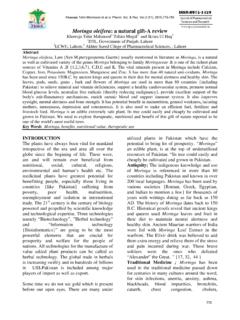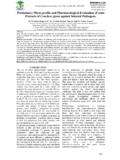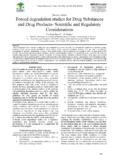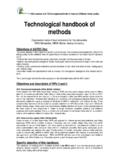Transcription of 07. TEAR SECRETION-a short review
1 Tear SECRETION-a short review J. Lakshmi Prabha First Year BDS Saveetha Dental College, Chennai, India Abstract: Tears are fluid secreted by the lacrimal glands of the eye which helps to moisten the eyes. Tears contain a wide variety of biologically active substances like mucin, electrolytes and other substances. Tears contain proteins including lysozyme, serum albumin etc. which have important functions. It also contains various chemicals, the most importantly those that are evoked by eye-irritants. Thiopropanal S-oxide which is a factor present in onions induces tear secretion by reflex mechanisms. There are three types of tear secretion namely basal, emotional and reflex. Generally females tend to cry more than men as their ability to express emotions are better.
2 Defect in tear secretion produces various disorders like dry eye, Sjogren s syndrome, crocodile tears etc. Keywords: tears, lacrimal, basal, emotional, reflex, dry eye, Sjogren s syndrome INTRODUCTION: Tears are the fluid secreted by the eyes to nourish it by maintaining a balance of the ingredients of the eyes and moisture content of the eye. Precorneal (tear) film is spread across the eye and it has three layers namely, lipid layer, aqueous layer and mucous layer. Lipid layer (secretes lipid) acts as an hydrophobic barrier and prevents the overflow of tears. Aqueous layer (contains water and tear proteins) acts as a physiological barrier and controls infection to the eyes. Mucous layer (secrete mucin) acts as a hydrophilic layer.
3 In a day, grams of tears is secreted which decreases with age [1]. Crying is considered healthy due to certain proteins present in it. People cry when they are alone especially adults. Other reasons why people cry include embarrassing or shameful situations, low level frustration or during sad, frightened, angry situations, while cutting onions and in situations that emotionally affects their brain. On average Women cry 30-64 times a year and men cry just 6-17 times in a year. The tears are secreted every second at the rate of 2 microlitres per minute or 10 ounces each day and are drained by the puncta which are wide. Thus there is overflow of tears during sneezing, vomiting, coughing yawning or any reflexes.
4 The tears are secreted by the lacrimal gland situated laterally. They are spread by periodic blinking of the eyelid and they are drained by the puncta, pass through the canaliculi and is drained into the lacrimal sac. Further it passes through the nasolacrimal duct and causes the nose to be stuffy when we cry. TEAR PROTEINS: Tear proteins are secreted by the lacrimal glands and contains lactoferrins, antimicrobial molecules, lacrimal secretory IgA etc. Lactoferrin (lactotransferrin) is a glycoprotein present majorly in neutrophils and secreted in small concentrations by exocrine glands including lacrimal glands. Lactoferrin is a part of specific defence of the body in an indirect way [2].
5 Lactoferrin has antimicrobial activity and is a carier protein. Today almost 60 tear proteins are known including the well known proteins like lacitin, proline rich proteins, lipocalin, lipophilin, etc. Lysozyme has antibacterial activity. Lipocalin 1 (prealbumin) and lipophilin A are carrier proteins. Some other proteins include apolipoproteins H, phospholipase A2, ribonuclease4, lipophilin C etc. [3]. Tears also contain IgA, IgD, IgG, IgA acts as a defence agent along with phagocytes and lisoymes present in the tear film. Hence they protect the eye from dust and other infectious agents [4]. TEAR FILM: Tear film is the thin layer of tear fluid secreted continuously by the lacrimal glands.
6 Tear film is important as the relation between the air and tear film is responsible for two- thirds of the total refractory power of the eye [5]. Tear film covers an area of 1-3 square cm and has a thickness of m [6]. Tear film break up time is used to check the stability of the tear film in case of dry eye and other eye disorders. It is seen that lithium carbonate and sodium valproate help in decreasing the time taken for tear film break up [7]. Cortisol and dihydroepiandrosterone are some stress biomarkers present in tear secretion [8]. Thickness of the tear film is contributed mainly by the aqueous secretions of the eye and it contributes nearly 60% of the total value [9].
7 Tear film is smooth layer formed during blinking and finally breaks up during evaporation. Thus the images become blurred with increase in time. Irregular tear films cause visual problems [10]. TYPES OF TEARING: Tear secretion is classified into three types namely, basal, emotional and reflex tears. Basal tears are secreted and spread continuously by the eyes. They moisten the eyes [1]. Reflex tears are those which are produced by pain, external stimulus or foreign bodies [11]. Hypo secretion is caused by dry eye and hyper secretion is caused by ocular inflammation, corneal or nasal irritations, etc. Although basal tears are vital for healthy eyes, reflex tears are secreted excessively than basal tears [12].
8 EMOTIONAL TEARING: Generally women tend to cry for six minute whereas men only for two- three minutes. People tend to cry to express their emotions in mainly two circumstances namely, requesting-help and offering-help. Previous classification J. Lakshmi Prabha /J. Pharm. Sci. & Res. Vol. 6(3), 2014,155-157 155classifies emotional tearing as positive and negative. Thus requesting-help includes only negative emotions but emotional-help includes both positive as well as negative emotions [11]. REFLEX TEARS DUE TO ONIONS: Tears are produced when certain chemicals are released while cutting an onion. These include methionine, cysteine, syn-propanethial-s-oxide.
9 When metionine and cysteine are released into the air, the enzyme lacrymatory factor synthetase allinases convertes sulfoxides into lacrymatory compounds like sulfuric acid, allyl sulphide which causes tear secretion. It can be reduced by keeping the onion in refrigerator (reduces enzyme activity), using without cutting the root part frequency of cutting onions using running water or fan while cutting, etc. TEARS AND ITS EFFECT ON AGING: During aging all physiological process tend to decrease and this attributes to decrease in tear secretion. Sometimes there is overflow of tears due to inefficient drainage function of the gland and blocks in the lachrymal ducts. Epiphora is a symptom which results from deficiency in the drainage of tear film.
10 There are two types of epiphora: chronic and acute conditions. Dry eye is caused in old age due to less tear secretion [12]. PHYSIOLOGY OF TEAR SECRETION: The sensory nerve for tear reflexes is the fifth cranial nerve- the trigeminal nerve. If this nerve is cut reflex tears alone are affected. When the corneal surface is exposed to cocaine, reflex tears are stopped even on exposure to strong gases which cause tear secretion. The tear secretion is regulated physiologically by cholinergic fibres of the parasympathetic nervous system, sympathetic stimulation to adrenal gland, certain peptides and humoral factors. Tear secretion is also controlled by epidermal growth factors.
















